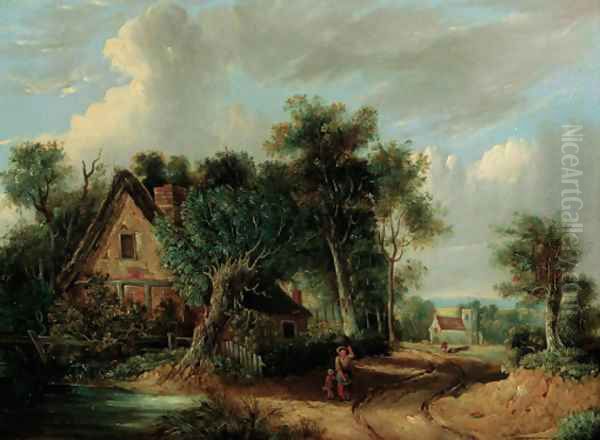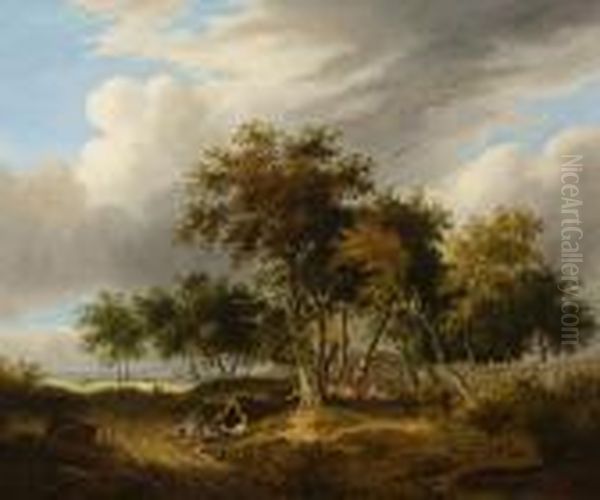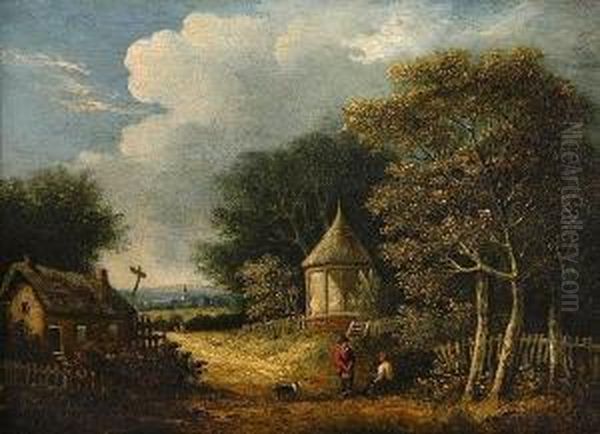Samuel David Colkett (1806-1863) was an English artist associated with the celebrated Norwich School of painters. Active during the first half of the 19th century, Colkett dedicated his career primarily to landscape painting, working proficiently in oils and watercolors, and also producing etchings. His work reflects the aesthetic principles and regional focus that characterized this important movement in British art history, capturing the gentle scenery of East Anglia with sensitivity and skill.
Though not as widely known today as the founders of the school, Colkett was a recognized artist in his time, contributing to the rich artistic output of the region and carrying forward the traditions established by his predecessors. His paintings offer valuable glimpses into the rural life and natural beauty of Norfolk and surrounding areas during a period of significant social and environmental change.
The Norwich School Context
The Norwich School holds a unique place in British art as the first significant provincial art movement outside of London. Flourishing primarily in the first half of the 19th century, its artists drew inspiration directly from the local Norfolk landscape – its broads, rivers, woodlands, and coastline. The school's aesthetic was deeply influenced by the Dutch Golden Age landscape painters of the 17th century, such as Meindert Hobbema and Jacob van Ruisdael, whose works emphasized naturalism, detailed observation, and the atmospheric effects of light.
The leading figures of the Norwich School were John Crome (often called "Old Crome") and John Sell Cotman. Crome, a founder of the Norwich Society of Artists in 1803, favoured a robust, earthy naturalism, while Cotman developed a more graphic, pattern-based style, particularly in his watercolors. Samuel David Colkett emerged within this environment, aligning himself more closely with the stylistic approach of Crome.
The Norwich Society of Artists provided a crucial platform for local artists to exhibit their work, fostering a sense of shared purpose and regional identity. Colkett participated in this artistic community, developing his skills and contributing to the school's collective vision of depicting the specific character and beauty of the East Anglian countryside.
Life and Career

Samuel David Colkett was born in 1806. While some sources suggest his birthplace was in East Anglia, potentially Norwich itself, definitive confirmation of his exact place of birth remains elusive from readily available records. His lifespan, 1806 to 1863, places him firmly within the active period of the Norwich School's main phase. He spent a significant part of his artistic life working in and around Norwich, the hub of the school's activity.
Historical accounts frequently identify Colkett as a pupil or follower of John Crome (1768-1821). Given Crome's foundational role and influence within the Norwich School, it is highly likely that Colkett studied his work closely, even if direct tutelage cannot be definitively proven for the entirety of his formative years. Crome's death in 1821 occurred when Colkett was still a teenager, suggesting any direct pupil-teacher relationship would have been during Colkett's youth, followed by a career built upon Crome's stylistic principles.
Details about Colkett's personal life and specific career trajectory are relatively scarce compared to the leading figures of the school. There are no widely recorded anecdotes or unusual events associated with him. His professional life appears to have been focused on the steady production of landscape paintings, watercolors, and etchings, primarily for a regional market, though like many provincial artists, he may have sought exhibition opportunities in London as well. His death in 1863 marked the passing of one of the dedicated practitioners of the Norwich School tradition.
Artistic Style and Influences
Samuel David Colkett's artistic style is characteristic of the Norwich School, particularly the branch influenced by John Crome. His primary subject matter was the landscape of Norfolk and surrounding East Anglian counties. He favoured depictions of rural scenes, often featuring cottages nestled amongst trees, winding country lanes, riverbanks, and wooded areas. His work generally conveys a sense of tranquility and an appreciation for the quiet beauty of the English countryside.
In his oil paintings, Colkett employed techniques that echoed Crome's naturalism. He paid close attention to the rendering of foliage, the texture of tree bark, and the play of light and shadow across the landscape. His compositions are typically well-structured, often using trees or buildings to frame views and create depth. His colour palette tends towards naturalistic greens, browns, and earth tones, capturing the specific atmospheric quality of the region.

Colkett was also a capable watercolorist. His works in this medium often display a similar focus on landscape, sometimes incorporating figures within the scene, as seen in titles like female figure in wooded landscape. While perhaps less known for innovation than figures like John Sell Cotman, his watercolors demonstrate competent handling of the medium, capturing light and form with washes and delicate brushwork. The influence of 17th-century Dutch masters, a hallmark of the Norwich School, is evident in the careful observation of nature and the emphasis on atmospheric realism found in Colkett's work. He also produced etchings, contributing to another facet of Norwich School artistic practice.
Representative Works
Several works help illustrate Samuel David Colkett's style and typical subjects. One notable example is Landscape with Cottage, an oil painting dated 1842. Measuring 39.2 x 50 cm, this work is held in the collection of the National Trust in the United Kingdom. The title itself suggests a quintessential Norwich School theme – the integration of humble rural architecture within a natural setting. Such paintings typically emphasize the harmony between human habitation and the surrounding landscape, rendered with attention to natural detail and lighting.
Another known work is a watercolor titled female figure in wooded landscape. This piece, measuring 19cm x 27cm, appeared at auction, demonstrating that his works continue to circulate on the art market. While the specific date of creation isn't firmly established from the provided context, it exemplifies his work in watercolor and his occasional inclusion of figures to add narrative interest or scale to his landscape scenes.
Other titles attributed to Colkett, such as A Gypsy Encampment, suggest a broader interest in different aspects of rural life, although detailed information or images for all attributed works may not be readily accessible. There is also mention of a work titled The Painted Church becomes Bury’s Cathedral, reportedly depicting the restoration of St James's Church in Bury St Edmunds. If accurate, this indicates an engagement with architectural subjects and specific local events, broadening his known subject range beyond pure landscape.
These examples showcase Colkett as an artist working firmly within the Norwich School idiom, focusing on landscape and rural scenes, executed with competence in both oil and watercolor. His works contribute to the visual record of 19th-century East Anglia.
Contemporaries and Connections
Samuel David Colkett worked during a vibrant period for British landscape painting, both within the Norwich School and nationally. His most direct artistic context was defined by the key figures of the Norwich School. He followed in the footsteps of its founders, John Crome ("Old Crome") and John Sell Cotman, whose distinct styles set the parameters for the movement.

Colkett's contemporaries within the school included other notable artists who absorbed and adapted the founders' influences. James Stark (1794-1859) and George Vincent (1796-c.1832) were prominent pupils of Crome, known for their detailed woodland scenes and river landscapes, respectively. Joseph Stannard (1797-1830) was another significant member, particularly skilled in marine subjects and known for his crisp, clear style. John Thirtle (1777-1839) excelled primarily as a watercolorist, capturing the atmospheric effects of Norfolk's weather and waterways.
The legacy of the school was also carried on by the sons of the founders, such as John Berney Crome (1794-1842), who continued his father's landscape style, often favouring moonlight scenes, and Miles Edmund Cotman (1810-1858), who worked closely with his father, John Sell Cotman, particularly in watercolor. Colkett's career overlapped with these figures, contributing to the collective identity of the school.
Beyond Norwich, the national landscape painting scene was dominated by giants like J.M.W. Turner (1775-1851) and John Constable (1776-1837). While their approaches differed significantly – Turner exploring sublime and atmospheric effects, Constable focusing on the empirical study of Suffolk landscapes – their work formed the broader backdrop against which regional schools like Norwich operated. Other respected landscape artists active during Colkett's time included David Cox (1783-1859), particularly renowned for his vigorous watercolors. Colkett's work represents a more localized, perhaps quieter, but nonetheless dedicated engagement with landscape art within this rich national context.
Legacy and Collections
Samuel David Colkett's legacy lies in his contribution as a consistent and skilled practitioner of the Norwich School style. While not achieving the fame of Crome or Cotman, he played a role in sustaining the school's focus on the faithful depiction of the East Anglian landscape through the mid-19th century. His paintings and watercolors provide valuable examples of the school's characteristic themes and techniques, particularly those aligned with the naturalistic tradition of John Crome.
His work is represented in public collections, indicating recognition of his artistic merit and historical importance. Notably, the National Trust holds his Landscape with Cottage (1842). The Victoria and Albert Museum (V&A) in London, a major repository of British art, also includes works by Colkett, acknowledging his place within the broader narrative of British painting and decorative arts.
The continued appearance of Samuel David Colkett's works at auction demonstrates an ongoing interest among collectors of British landscape painting and the Norwich School specifically. His paintings offer accessible examples of the school's charm and dedication to capturing the essence of a particular English region. He remains a figure worthy of attention for those studying the development of landscape art in Britain.
Conclusion
Samuel David Colkett stands as a representative artist of the Norwich School, a movement defined by its deep connection to the landscapes of East Anglia and its inspiration from Dutch masters. Active from 1806 to 1863, he worked diligently in oil, watercolor, and etching, producing numerous scenes that capture the tranquil beauty of the Norfolk countryside. Strongly influenced by John Crome, his work embodies the naturalistic ethos that characterized much of the school's output. Though perhaps overshadowed by the founding figures, Colkett's consistent dedication and skill earned him a place within this significant chapter of British art history, and his works continue to be appreciated for their gentle charm and faithful representation of a bygone rural England.